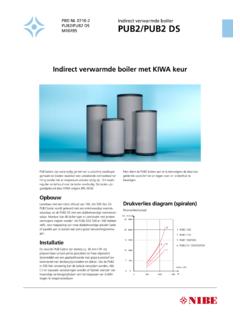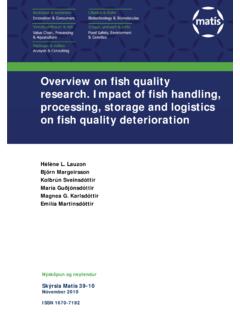Transcription of Ectoparasites and classification - Home: OIE
1 Rev. sci. tech. Off. int. Epiz., 1994,13 (4), 985-1017 Ectoparasites and classification CE. HOPLA *, DURDEN ** and KEIRANS ** Summary: The authors present an introductory overview of the principal groups of Ectoparasites (flukes, leeches, crustaceans, insects, arachnids, lampreys and vampire bats) associated with domestic animals. Currently-accepted higher-level classifications are outlined for these parasites. Almost all significant Ectoparasites of domestic animals are invertebrates, the majority being arthropods (crustaceans, insects and arachnids).
2 Some of these Ectoparasites are of particular importance as vectors of pathogens. Many ectoparasite species are host-specific, and vector species typically transmit characteristic pathogens. KEYWORDS: classification - Domestic animals - Ectoparasites - Pathogen transmission - Vector-borne diseases. INTRODUCTION Ectoparasites are organisms which inhabit the skin or outgrowths of the skin of another organism (the host) for various periods, and may be detrimental to the latter. Various Ectoparasites cause significant infestations in many kinds of domestic animals including livestock, pets, laboratory animals, poultry, fish and bees (28,39,55).
3 Many of these Ectoparasites ( most lice) are host specific, while others ( many ticks) parasitize a wider range of hosts. Several Ectoparasites currently associated with domestic animals have been acquired by the introduction of either host or parasite into new regions, as animals have become domesticated throughout the world. For example, cattle, goats, and other important domestic livestock species have been introduced into much of Africa, where they may now fall victim to the ravages of native tsetse flies (Glossina spp.) and ticks, as well as pathogens transmitted by these parasites. Relatively rapid intercontinental transportation of these animals has compounded the problem.
4 The vast majority of Ectoparasites are invertebrates. Most invertebrate Ectoparasites are arthropods; insects and arachnids typically parasitize terrestrial domestic animals, while crustaceans are associated with fish. Many Ectoparasites are known to be vectors of pathogens, which the parasites typically transmit to hosts while feeding or (occasionally) defaecating. However, Ectoparasites - especially in large aggregations - may also debilitate domestic animals in other ways, by causing the following disorders (39,65,66,88): - anaemia - detrimental immune reactions (hypersensitivity, anaphylaxis, etc.)
5 * Emeritus, Department of Zoology, The University of Oklahoma, 730 Van Vleet Oval, Room 314, Norman, Oklahoma 73019-0235, United States of America. ** Institute of Arthropodology and Parasitology, Georgia Southern University, Landrum, Box 8056, Statesboro, Georgia 30460-8056, United States of America. 986 - irritability - dermatitis - skin necrosis - low weight gains (particularly important in livestock) - secondary infection - focal haemorrhages - blockage of orifices (ears, etc.) - inoculation of toxins - exsanguination (occasionally). Subdermally-located parasitic larval stages of certain flies cause a condition termed 'myiasis', which may lead to significant tissue damage and secondary infection (11, 50, 100).
6 Nevertheless, ectoparasite infestations of many domestic animals are minor and seem to cause little harm to the host. This introductory chapter will briefly outline the main characteristics, higher-level classification and economic importance of the principal metazoan Ectoparasites affecting domestic animals. Less coverage is given to Ectoparasites associated with laboratory animals, and for further details on this subject, readers are referred to a previous review (28). However, more information is provided on Ectoparasites of bees and fish, as these areas are not dealt with elsewhere in this volume, and also on those of birds, not fully covered elsewhere.
7 This chapter attempts to follow a natural (phylogenetic) classification for the Ectoparasites discussed. Table I is a taxonomic compilation of the principal Ectoparasites of various domestic animals and the main pathogens transmitted by these parasites. Both in Table I and throughout this brief overview, the various taxa of Ectoparasites are considered on an evolutionary scale by sequentially addressing flukes, leeches, arthropods and finally vertebrates. FLUKES AND LEECHES Some species of flukes (Platyhelminthes: Trematoda), such as Gyrodactylus spp., are Ectoparasites of fish and can cause serious damage to cultured species (3, 38, 42).
8 However, most flukes which parasitize fish are endoparasitic. Although many leeches (Annelida: Hirudinea) are free-living, certain species parasitize fish and sometimes also domestic and laboratory animals (crocodilians, macaques, etc.). Some leeches can transmit haemoflagellate or sporozoan protozoans to vertebrate hosts during blood-feeding (97). The fish leech (Piscicola geometria) can transmit spring viraemia carp virus (SVCV) to carp (2); another fish pathogen, infectious haematopoietic necrosis (IHN) virus, has also been isolated from this leech (63). CRUSTACEANS A wide variety of crustaceans feature prominently as fish Ectoparasites and some species adversely affect domestic fish stocks.
9 Fish culture (farming) is a branch of animal husbandry which dates back hundreds of years in Asia and Europe. Fish farming 987 practices have been refined and production has increased over time. Since the 1950s, an explosive growth has been witnessed in the fish culture industry. Historically, cyprinid fish species of Asian origin ( various species of carp, tench and peleds) were adapted to fish farming practices. Later, warmwater species ( catfish: Ictalurus) were adapted to fish farming in the southern United States of America (USA), thence being introduced to developing countries in Africa, and thus became a reliable source of protein in the human diet in these regions.
10 Fish farming is currently practised on all continents except Antarctica. The most recent development has been the enormous progress in rearing anadromous and catadronous fish species using 'netpen' technology in temperate regions of the northern hemisphere. Facilities for saltwater fish farming have been developed even inland, adjacent to favourable coastlines. Kent (46) indicated that the use of netpen practices would increase salmon production in Canada by 250% between 1989 and the year 2000. Ectoparasites are usually a minor problem under pond or hatchery conditions, as they can be eliminated quickly using externally-applied therapeutic agents.

















